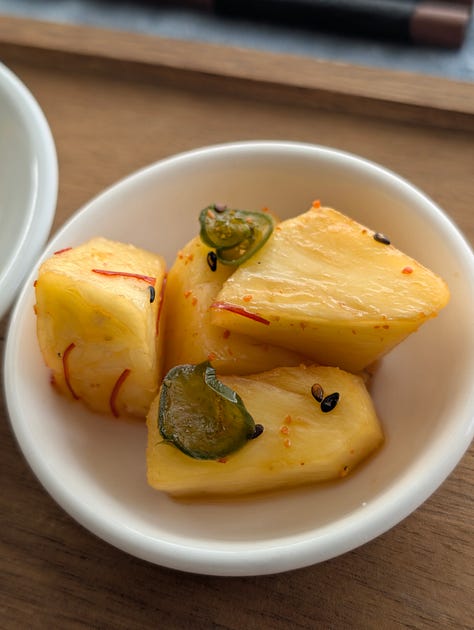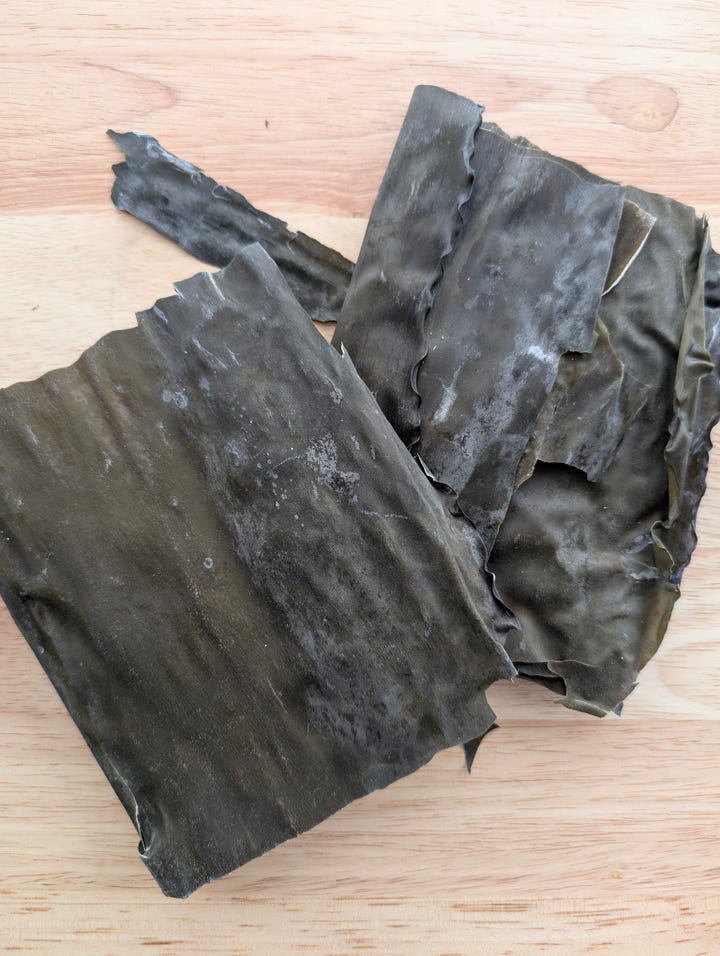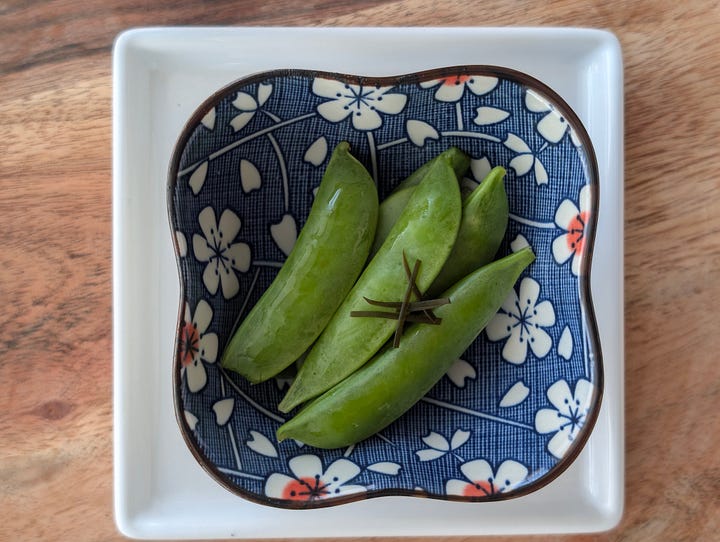When I first started making sushi in Mississippi, I was fascinated by how often pickles appeared in Japanese cookbooks. Pickled daikon. Pickled ginger. Pickled eggplant. Pickled burdock root. But there was one small problem. I couldn’t find any of them at my local Asian market.
So, I had to make them myself.
Luckily, those same cookbooks reassured me that pickling wasn’t some daunting, all day process. In Japanese home kitchens, pickled vegetables were made regularly, often several times a week. That was a relief because my only reference for pickling involved my grandmother’s intense summer canning projects. Glass jars everywhere, mountains of produce, the eye-watering sting of spiced hot vinegar, and the ever-present fear that the pressure cooker might explode and take out an eye (stories I now suspect were less about real danger and more about keeping me and my cousins out of the way).
Japanese-style pickles, I quickly learned, were a very different thing. With just a few simple ingredients, I could transform vegetables into something bright, crisp, and deeply flavorful in as little as 30 minutes. No canning required!
Even now, with access to a great local Japanese grocery store, I still love making my own pickles. It gives me the freedom to experiment with different vegetables (and fruits!) and play with flavor enhancers to make them truly my own.



Tsukemono - Japanese Pickles
If you’ve ever enjoyed the satisfying crunch of pickled ginger between bites of sushi, you’re already a fan of tsukemono, Japanese pickles. But pickles don’t just accompany sushi; they’re often part of it, too. Takuan (bright yellow pickled daikon) and yamagobo (earthy pickled burdock root) may be familiar if you’ve enjoyed vegetable rolls at your favorite sushi bar.
Beyond sushi, tsukemono play a much bigger role in Japanese cuisine. They bring balance, contrast, and depth to a meal, whether served as a palate cleanser, a bright counterpoint to rich dishes, or a simple way to enhance seasonal produce. From salty-sweet miso pickles to crisp, refreshing brined vegetables, there’s a whole world of Japanese pickles beyond that familiar side of ginger.
Japanese Pickling Methods
Over centuries, Japan has developed a range of pickling methods, from quick and light cures to long, slow fermentation. Some pickles are meant to be enjoyed within hours, while others take weeks or even months to develop their signature flavors.
For this deep dive, we’re focusing on three incredibly accessible techniques that you can easily make at home. These are quick pickles, so no actual fermentation takes place. Think of these methods as simple ways to create flavorful transformations. If you’ve ever been intimidated by pickling methods that require sterilizing jars and precise conditions, you’re going to love how effortless these are.
One quick note: Since these aren’t fermented, they do require refrigeration.
Shiozuke (Salt-Brined Pickles) – Clean & Crisp
The simplest and oldest form of pickling in Japan, shiozuke relies on salt to draw out moisture and intensify natural flavors. The result is a clean, crisp pickle that brings out the best qualities of the vegetables.
Shiozuke at a glance:
Salt Rub Method: Vegetables (like cucumbers) are sprinkled with salt and gently massaged or pressed to extract water, firm up texture, and develop a light, refreshing brine.
Salt Brine method: Vegetables soak in a lightly salted water solution for several hours, allowing them to absorb seasoning while staying crunchy.
Sometimes kombu (dried sea kelp) is added for a boost of umami.
Ready in 30 minutes to 8 hours, depending on the method.
Recipes using this method in the guide:
Salt-Pickled Cucumbers (salt rub method)
Sugar Snap Peas with Kombu (salt brine method)
Mixed Radish and Sakura
Amazuzuke (Sweet Vinegar Pickles) – Bright & Tangy
If you’re looking for a fast, flavorful pickle, try amazuzuke. Vegetables (and sometimes fruit) are quick-pickled in a lightly sweet and acidic brine, making them refreshing and versatile.
Amazuzuke at a glance:
Vegetables are pickled in a simple brine of rice vinegar, sugar, and salt.
Because they aren’t fermented, amazuzuke pickles keep their crisp texture and have a delicate, refreshing flavor.
Ready in a few hours to overnight.
Recipes using this method in the guide:
Quick Pickled Daikon
Citrus Pickled Baby Carrots
Pickled Pineberries with Peppercorn & Ginger
Shōyuzuke (Soy Sauce Pickles) – Deep & Umami-Rich
For a bold pickle, the shōyuzuke method infuses deep flavor with a soy sauce-based brine.
Shōyuzuke at a glance:
Vegetables (or fruit) are brined in a soy sauce base.
The longer they sit, the stronger and more complex their flavor becomes.
Time: Ready in a few hours but some are best after 1–2 days.
Recipes using this method in the guide:
Soy-Pickled Shiitake Mushrooms
Soy-Pickled Baby Leeks
Spicy Soy-Pickled Pineapple
Beyond These Methods…
Japan’s pickling traditions go far beyond these three methods. Some of the more complex and long-fermented styles include:
Nukazuke – Vegetables fermented in a rice bran bed, rich in probiotics and deep flavors.
Misozuke – Pickles cured in miso paste, resulting in a bold flavor.
Shio Koji – A naturally fermented rice seasoning that enhances vegetables with gentle sweetness, umami, and tenderizing properties.
Each of these methods brings something special to the table, and we’ll explore them in a future deep dive!
Ingredient Spotlight: Kombu


What is kombu?
Kombu is a type of dried kelp (a sea vegetable) that’s packed with natural flavor-enhancing compounds. It’s one of the essential ingredients in Japanese cooking, best known for making dashi (Japanese stock) but also playing a key role in pickling. Kombu adds depth and a subtle savoriness without overpowering the core flavor of the ingredients.
The natural glutamates, compounds that enhance savory depth, in kombu help soften the texture of pickled vegetables while boosting their overall flavor. In salt-brined pickles (shiozuke), kombu is often added to subtly enhance savoriness while keeping flavors clean and fresh (example: Sugar Snap Peas with Kombu). When used in a soy-based pickle brine (shōyuzuke), it deepens the flavors, making the soy more complex and layered.
Prepping Kombu: Wipe, But Not Too Much
Kombu naturally has a white powdery coating that is a key part of its flavor, so don’t rinse it off! This surface layer helps develop the depth and savoriness kombu is known for. Before using, simply wipe the kombu with a damp cloth or paper towel to remove any dirt or grit while keeping the good stuff intact.
Where to Find Kombu & Storage Tips
Where to Buy: Most Asian grocery stores, specialty spice shops, or online retailers.
How to Store: Keep in an airtight container in a cool, dry place. It lasts indefinitely if kept dry.
Don’t Throw It Out! Kombu Has a Second Life
Even after being used in pickling or broth, kombu still has plenty of flavor and can be repurposed in other dishes. Simmer it in soy sauce and mirin until tender, then chop it finely for a savory condiment. Mix it into rice or use it as a filling for onigiri. You can also toss softened kombu into stir-fries, adding a subtle umami boost to vegetables or noodles. However you use it, kombu has more to give!
Ready to Get Pickling?
Download the Tsukemono 101 guide and start making flavorful pickles at home! Inside, you’ll find:
Step-by-step instructions for three easy pickling methods:
Shiozuke (Salt Pickles) – Light, crisp, and refreshing
Amazuzuke (Sweet Vinegar Pickles) – Bright, tangy, and slightly sweet
Shōyuzuke (Soy Sauce Pickles) – Deep, umami-packed flavors
9 Pickle Recipes – A mix of classic and modern twists to explore new flavors.







Thanks for this guide. I'm just starting my Japanese pickle journey, researching the ferments but I'm going to make some quick pickles to tide me over!
I can't wait to try some of these! I've always stopped at quick pickled onions and the occasional end of season peppers.
I also love the idea of giving kombu a second life. I use it in my soups and when I cook dry beans and have never thought to reuse it...